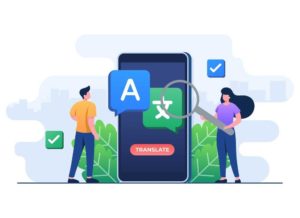Medical interpreter apps are slowly becoming the new normal, but when we talk about the certification of medical interpreter apps proper procedure is yet to be developed. But that does not mean that there are no regulations in place. There are certain regulations which are to be followed.
Regulatory Considerations for Medical Interpreter App Certification
Before healthcare facilities adopt medical interpreter apps, it’s crucial to understand the existing laws and regulations that may impact their usage.

Ensuring compliance with regulations such as HIPAA is paramount, as these apps handle sensitive patient information. Additionally, healthcare standards that govern language services should be considered.
Accreditation and Quality Assurance
To enhance trust and reliability, app developers should explore the possibility of seeking app accreditation as a language service provider tool.
Partnering with certified medical interpreters and interpreter associations can add credibility to the app. Implementing quality assurance measures will also ensure accurate and reliable interpretations.
Essential Features of a Medical Interpreter App
A successful medical interpreter app should possess essential features that meet the needs of healthcare providers and patients alike.
These features include comprehensive multi-language support with an extensive language database, real-time interpretation for effective communication, and audio and video capabilities for enhanced interactions.
Additionally, the app should prioritize secure communication channels to protect patient information. These are not only moral considerations but the laws also demand that the privacy of patients should be kept at all costs.
Cultural Competence in Medical Interpreting
Cultural sensitivity plays a crucial role in healthcare communication. App developers must take into consideration cultural nuances in app design to ensure culturally appropriate interpretations and interactions.

This will lead to better patient satisfaction and a more inclusive healthcare environment. The Civil Rights Act of 1964 prohibits any discrimination based on race, religion, sex or national origin, so while developing a medical interpreter app it is compulsory to make sure that your app is not breaking any of these laws.
The app must fulfil these requirements and must not hurt the sentiments of any cultural or ethnic group. If not so, such acts are punishable by law.
User Experience and Feedback
Gathering user feedback from healthcare providers and patients is vital to continuously improve the app’s functionality and usability.
Incorporating this feedback will enhance the overall user experience, making the app more effective and user-friendly. Including case studies or testimonials showcasing positive user experiences can also instil confidence in potential users.
Although it is not any criteria for the certification of the app, it does have a good impact when you want to certify the app. After all, when your app is receiving good reviews from the user it stands out from the crowd and is considered more reliable.
Security and Privacy Measures
Data security is of utmost importance when dealing with sensitive patient information. App developers must adhere to strict data security measures in compliance with HIPAA and other relevant regulations.
Implementing encryption and other safeguards will protect patient privacy and confidentiality. Transparency in data handling and privacy policies will further establish trust with users.

In the United States, the California Consumer Privacy Act (CCPA) and the Health Insurance Portability and Accountability Act (HIPAA) govern the protection of consumer data and healthcare data, respectively.
If your translator app leaks the information of any of the users it is punishable by law and the issue is serious enough that it can even lead to the taking down of your app by the authorities.
Continuous Development and Updates
To remain relevant and meet evolving user needs, medical interpreter apps should embrace continuous development and updates.
Staying informed about advancements in language services and healthcare trends is essential. Regular updates will ensure that the app remains effective and efficient.
If your app is not up to date its functionality can be affected and this can also make the users leave the app and search for more up-to-date and functional apps.
Industry Partnerships and Collaborations
Collaborating with healthcare organizations and language service providers can open doors to valuable insights and support.
Industry experts can offer guidance on improving app usability and adoption. Leveraging partnerships will lead to a more robust and widely accepted medical interpreter app.

If the authorities and the users are looking at your app and you have professional medical specialists in your team this can suddenly increase the credibility of the app.
On the other hand when your app has all the necessary updates but it does not have professionals in the field this will make both the authorities and users uncomfortable and lose hope in your app.
Conclusion
Medical interpreter apps are still in their infancy and the authorities are yet to develop proper rules and regulations specifically for these apps. But there are certain rules and regulations and moral and ethical considerations as well that should be kept in mind while developing a medical interpreter app. If these rules are not followed properly the certification process can be hindered.
FAQs
A medical interpreter facilitates oral communication in healthcare settings, while a translator works with written documents.
To become a medical interpreter in Canada, achieve fluency in English and another language, complete training, and obtain certification.
The average US salary for a healthcare language interpreter is approximately $50,000 annually.
To become an interpreter in Massachusetts, attain proficiency in English and another language, undergo relevant training, and pursue any necessary certifications.







